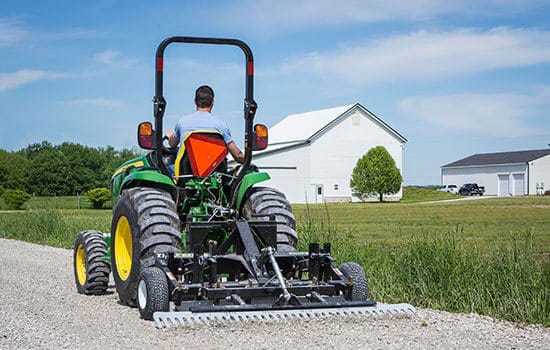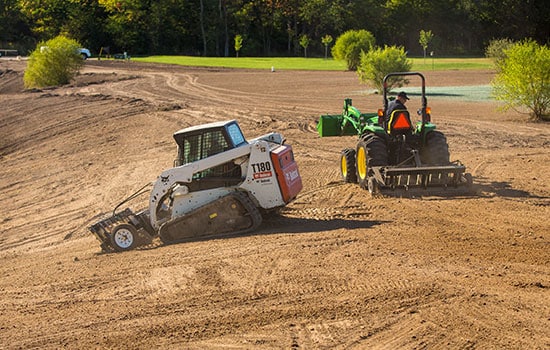Gravel Driveway Repairs – Dealing With Potholes – ABI Dirt
Did old man winter leave you with some nasty potholes in your gravel driveway? Don’t stress yet; you can handle it! In this episode of the ABI Dirt, Matt talks through the anatomy of a pothole and your best plan of attack to get them gone!
ABI Products Shown In This Video
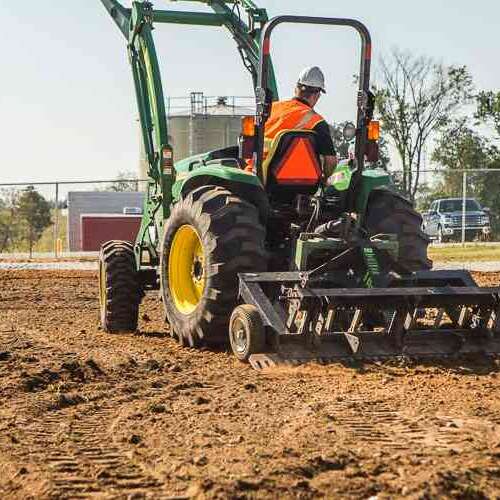
TR3 Grading Rake
- Commercial Contractor Landscape Rake
- 7.5' Width - Commercial-Duty
- Starting At: $184/mo.*
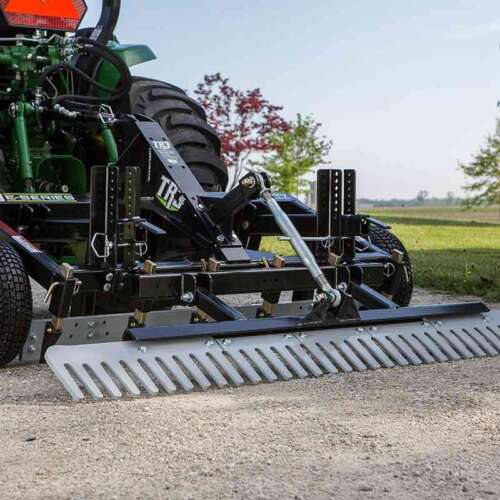
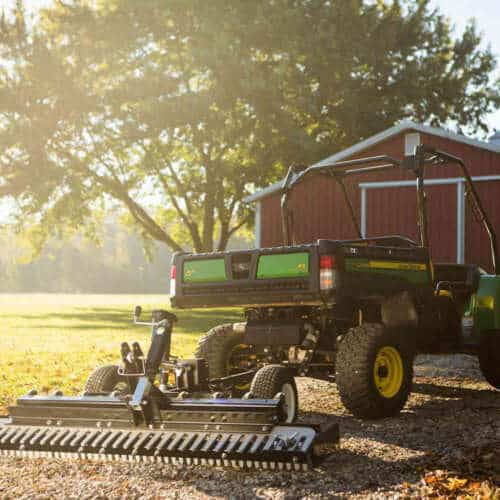
ABI Gravel Rascal Pro
- For ATVs, UTVs, & Sub-Compact Tractors
- 4.5', 5.5', 6.5', & 7.5' Widths
- Starting At: $94/mo.*
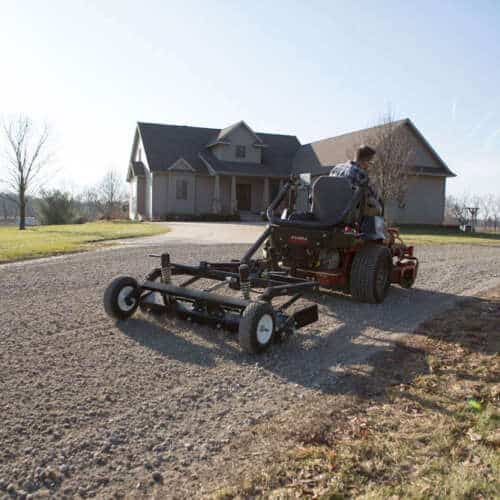
ABI Gravel Grader®
- For Lawn Tractors, Zero-Turn Mowers, & Utility Golf Carts
- 4' Width
- Starting At: $64/mo.*
Transcript
Hi, everyone, Matt here with ABI Attachments, welcome back to another episode of the ABI Dirt. Last week here on the Dirt, I gave you the one suggestion and you knew I’d be back for more because that’s why you come back too. One thing to think about as you can now see your gravel driveway, the snow is gone for most of us, I know you great northerners love that stuff so you’re still dealing with it, sorry. But for the rest of us that we can see our gravel driveway, the snow is gone, we can see how messy that driveway is because of the snow plows in and out all winter long, and you wanna clean it up.
And the suggestion last week was dig first, think dig first, you may not need new gravel, right? That was your 30-second recap from last week. This week, we wanna come back around with a couple more suggestions on how to address those pesky little critters known as potholes. Now that you can see your gravel driveway, now that you’re thinking that you might have the ability to tackle that driveway on your own this season without buying new gravel, let’s talk about, in particular, potholes and how to get rid of ’em. Here we go.
Understanding How Your Gravel Driveway Was Constructed
The first thing I want you to keep in mind before we dig into anything, this is kind of like calling, was it the 411, right? Where they come out and they mark your stuff, right? And that’s important too. If you don’t know where your pipes are, make sure you do. What I want you to consider before you dig into potholes, and we talk about how to aggressively take care of them, is how was your driveway constructed? Do you know? Do you know if you’ve got an official base down there or not? Because some driveways that are put in formally, officially done the very technical right way, done to spec means that you’ve got a couple of different types of material on that gravel drive. You could have some really large stuff down in the base of that gravel drive, or some really small stuff that’s been packed really tight. You don’t wanna tear that up.
So if you know, for sure, that your driveway was put in the most technical and complex way, know how much base you’ve got to work with, know how deep you need to go in order to tear it up. Because if you’ve got some really big rocks as the base foundation of that multi-layer driveway, and you dig too deep, you could pop some of those up and that’s not very fun to fix. So try to dig down in some obscure place, see how many layers you got and what you’ve got to work with, just keep that in mind as you dig into the project. When it comes to digging into those potholes though, there is gonna be some digging involved. I’m gonna say digging like so many times this episode, sorry, just the way it is.
Common Ways People Try to Deal With Potholes in Gravel Driveways
The most common way to deal with a pothole, it’s the easiest way, it’s the fastest way, it’s the way that you may have done already many times, and if you’ve done it this way, then this is why they keep coming back, sorry to break it to you. The easiest way to dig into a pothole is to work your way around that pothole, kind of chip up some of the gravel and try to scrape it back in, or maybe find some loose stuff from over here and rake it over a little bit and just put more gravel in it. Or maybe you’ve got a pile of gravel in your lot somewhere, your property somewhere, and you’re just gonna fill that hole back in. Pothole education says the pothole, it’s a pot, and you’ve got some really hard-packed sidewalls there.
If you just beautify it and put more gravel in it, the pothole’s gonna laugh at you in a couple of weeks as you drive over it again and again and again and all that new gravel you put in, maybe you paid for, just getting dumped right back out again. That didn’t solve the problem. In order to take care of that pothole, it’s gonna take a little bit more time, a little bit more energy. Sorry to say, you’ve got to break down the walls of that pothole. We’re talking about getting at least as deep as the deepest point of the hole, and realistically, you should go at least 12 to 24 inches around the circumference of that hole.
Now that could be a pretty sizeable spot of your drive depending on the size of the pothole you’re working with. But that’s the only way to actually get rid of the pothole and get your driveway back to the quality, back to the non-teeth chattering state it was in before that pothole arrived. So how do we get there? Well, you could and pull out your trusty pickax out of the garage or the barn and you could pull out the trusty metal straight rake and shovel and get to work, that’s one way to do it. But if you’ve got lots of potholes, or you’ve got a long driveway and that’s kind of intimidating, the other option is that you could use your horsepower instead of your back power. See what I did there? Right, if you’re used to using your four-wheeler, your side-by-side as a knock-around vehicle around the property just for transport purposes, you have a tow vehicle that is perfectly suitable to hook up to some kind of attachment and do a lot of this work for you.
Which Attachments Will Work for Dealing With Potholes?
Now, some of you have a whole slew of attachments and you’re like, “Matt, I don’t have any gravel driveway attachments on my property that can handle this kind of work to actually get rid of potholes, I’ve tried it.” Yes, there are a lot of products out there that say they’re great for gravel work or driveway maintenance, and it just kind of scratches the surface because they weren’t ever intended to actually dig up the pothole, get down as deep as you need it to go and get the work done. A lot of the gravel maintenance tools and attachments in the market, they make it look pretty for a little bit, they kind of take the loose stuff and they move it into the holes, but we just established that that doesn’t actually solve the problem. It kind of beautifies it for the big party you’re having on Saturday evening, which you didn’t invite me to by the way, I’m still hurt about that. But it doesn’t actually take care of the pothole problem. If you actually want to strategically, intentionally take care of the technical problems with the driveway, you need a tool that can loosen and level and finish and rake on the back.
Getting to the Bottom of the Issue
You need to be able to de-compact down to the bottom of the pothole, you need to be able to level it and yes, it is possible to level with a tractor and four-wheeler attachment, even a large garden tractor actually. And you need to have a nice smooth finish because if you can de-compact and level and finish, it means those potholes are less likely to come back. And a final thought for the day, if you do so on a regular basis if you work every other weekend or so throughout the warm weather season, even if it’s once a month to keep that driveway looking nice, you’re gonna have way fewer issues on this annual restoration you seem to be doing every spring that you could be avoided from here on out.
So if you don’t have an attachment as you’re looking at your attachments going, “Man, this is not ever really ever worked for me.” If you are looking for something that can save you a whole lot of time and hopefully a whole lot of money on those gravel purchases as well, that’s why we’re here. Give us a call, let our factory reps know what you’re working on, how long your driveway is, what kind of gravel you’ve got there, where in the country you’re at right now, we’d love to help find an attachment that can help you out. See you next time, everyone.

